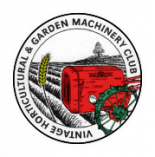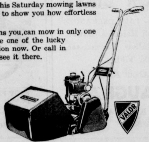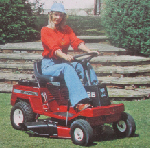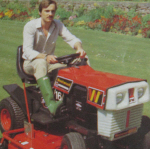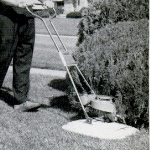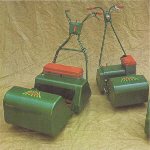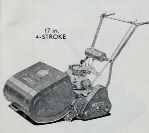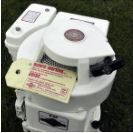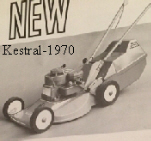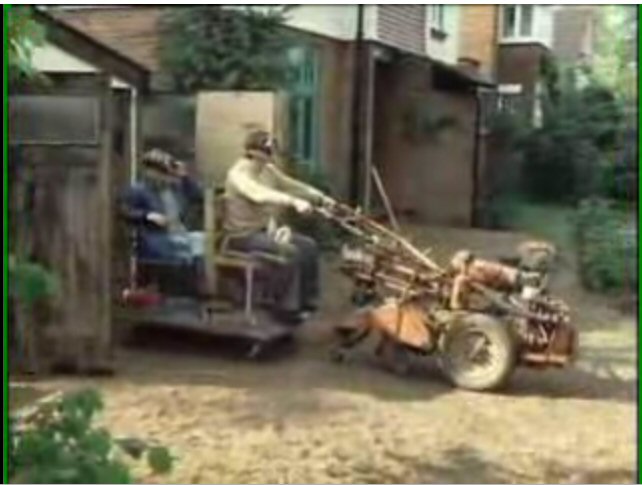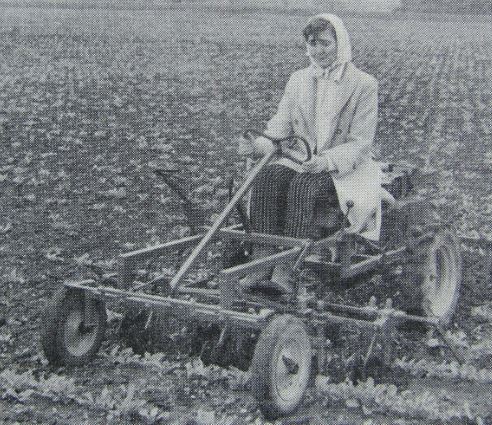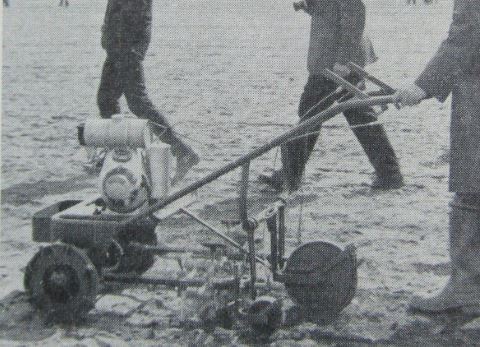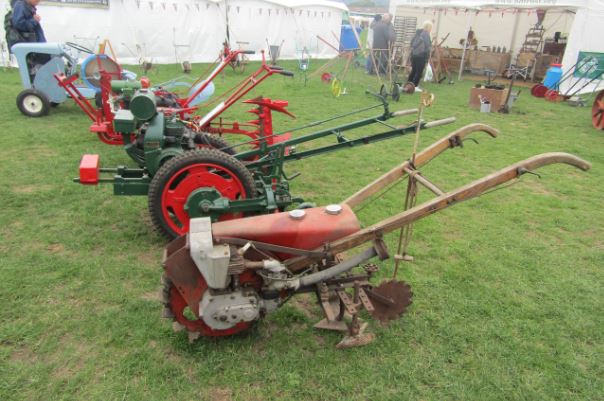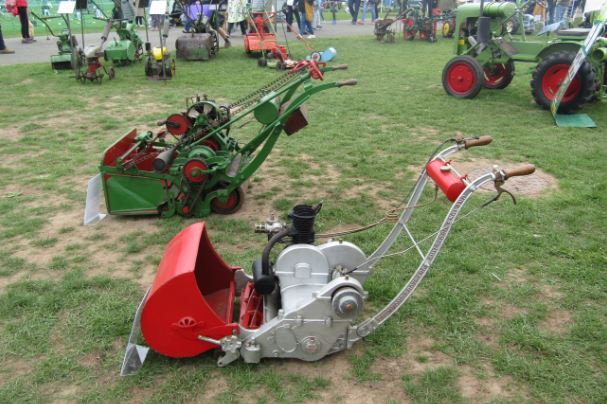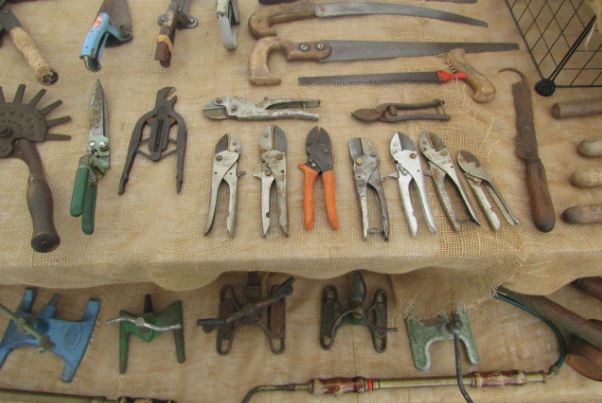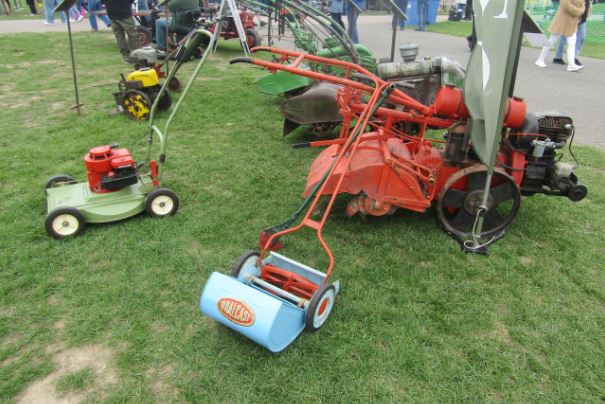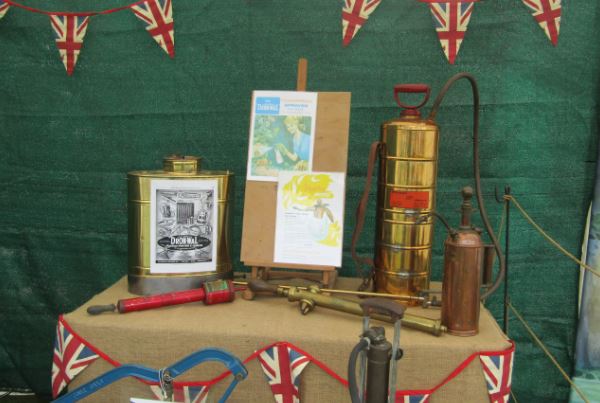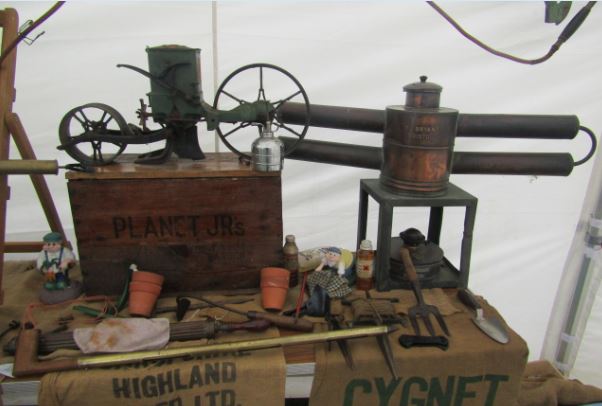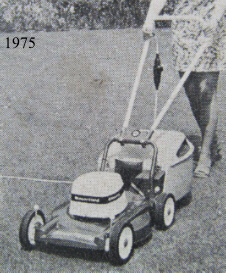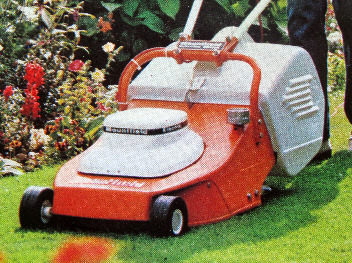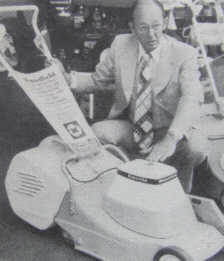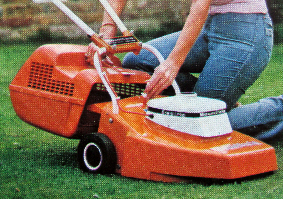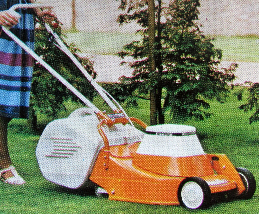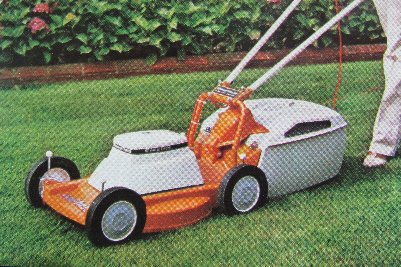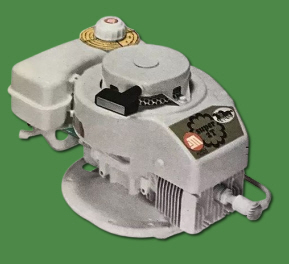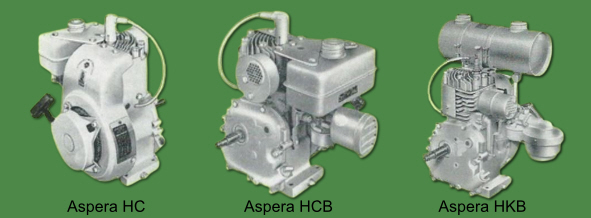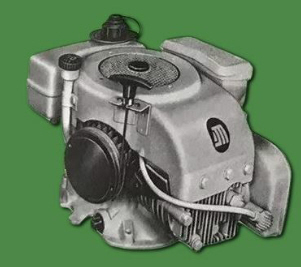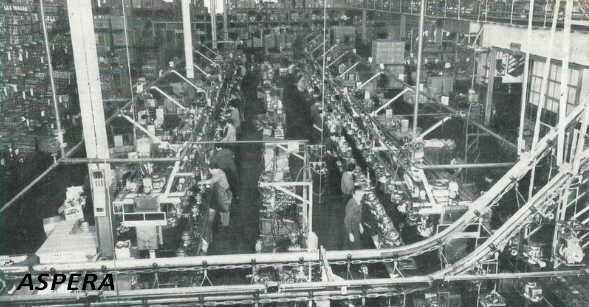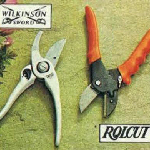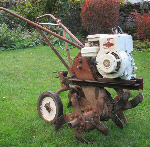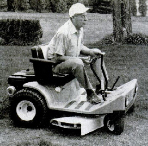Quiz 2025 – As Seen On TV
December 13, 2025 in Articles
Here are twelve questions for a short quiz.
The theme this year is mowers that have been on TV or in magazines, and sometimes associated with well-known people.
It shouldn’t be a challenging quiz. If you have seen Only Fools and Horses, One Foot in the Grave, marvelled at Jim Bowen on Bullseye, watched Wallace & Grommit, or know who sang ‘Green, Green Grass of Home’, then this is the ideal quiz to pass a few minutes.
A pencil and paper are handy to write down the answers.
As always, the answers are at the bottom of the page.
Questions:
1: Which famous Welsh singer was photographed in 1967 at their Shepperton home with a gold-coloured Valor Ironcrete petrol-powered lawn mower? It was said that this mower was specially painted and presented in recognition of their worldwide No. 1 hit with ‘Green, Green Grass of Home’ in 1966.
A: Tom Jones
B: Dame Shirley Bassey
C: Sir Harry Secombe
2: In the 1990s TV comedy series One Foot In The Grave, Victor Meldrew played by Richard Wilson was always having mishaps. In one episode, he accidentally inhaled some fertilizer and got very high and jolly, before climbing aboard a ride on mower. Eventually driving into a house and shredding a carpet, as well as other disasters. But what was this rear-engine ride-on mower that was popular in the UK?
A: Reo Lawn Skiff
B: Mountfield M25
C: Toro Whirlwind
3: In the brilliant Aardman Animations 2024 film Vengence Most Fowl, what type of lawnmower does Wallace & Grommit own? And used by Norbot the gnome to unhelpfully tidy-up Grommit’s cottage garden but instead destroying it.
A: Cylinder mower
B: Rotary mower
C: Hover mower
4: In 1973, Rod Stewart, of singing fame, was photographed in the UK sitting on his red-painted, Kohler-powered, ride-on mower/garden tractor outside his house. But what make was Rod Stewart’s tractor? (Clue: Only one of them was being made in 1973).
A: Westwood
B: Countax
C: Wheel Horse
5: In 1983, television adverts for a certain mower used the slogan ‘It’s a lot less bovver than a hover’. One advert featured the actor Nicholas Smith – who also starred as Mr Rumbold in Are You Being Served? But what mower brand was being sold in the adverts, which was (allegedly) better than the hover mowers?
A: Qualcast
B: ATCO
C: Hayter
6: In 1980, Mountfield adverts for Wheel Horse tractors featured which Scottish motor racing champion? He also advertised the tractors in the USA. Among other races, he won the 1965 Italian Grand Prix, but obviously not on a Wheel Horse. Who was he?
A: Jim Clark
B: Colin McRae
C: Jackie Stewart
7: In the mid-1970s, which TV personality, who presented Gardeners’ World, did Wolseley Webb recruit to lead their sales campaign of mowers and tillers? It is the earliest presenter – but which one was that?
A: Percy Thrower
B: Geoff Hamilton
C: Geoffrey Smith
8: In the 1994 USA film Forest Gump, which real make of ride-on mower, with a Turtle inspired logo, did Forest use?
A: Tortrak
B: Snapper
C: Snap-Jack
9: In the 1965 comedy film The Early Bird, about Grimsdale Dairy, which slapstick actor (dressed as a milkman) gets dragged around a garden by an ATCO cylinder lawnmower before ending up in a pond? (I think the name Mr Grimsdale! might give it away).
A: Eric Sykes
B: Norman Wisdom
C: George Formby
10: In the 1983 episode of Only Fools and Horses named ‘Healthy Competition’, Rodney and Mickey were tricked by Del Boy into buying which horticulturally-related item at auction?
A: A rotavator which wouldn’t rotavate
B: A heap of old lawnmower engines
C: A collection of woodwormed vintage garden tools
11: In 1982, the TV series Open All Hours featured the episode ‘The Ginger Men’. In the episode, Granville buys a second-hand mower with the intention of fitting the engine to his shop bike. What make of British mower did he buy? (and consequently leave on the shop floor for the bun salesman to fall over).
A: Suffolk Punch
B: Hayter Kestral
C: Landmaster Sovereign
12: The original version of the darts quiz show Bullseye aired from 1981 until 1995. It was presented by Jim Bowen, who was often quoted (or misquoted) using the words “super” and “smashing” to describe things. Anyway, which of these super, smashing prizes could be won on Bullseye for just “the throw of a dart”?
A: Black & Decker H1 Hover Mower, together with a B&D electric lawn rake, a Fisons lawn spreader, a bag of lawn weed & feed, and a pair of lawn edging shears.
B: 5-door Morris Ital car in white paintwork
C: £2000 clothing spending spree – possibly at C&A
Answers:
1: A: Tom Jones. He was presented with a gold-painted Ironcrete Valor mower in 1967. He had sold over one million copies of his recording of ‘Green, green grass of home’ – hence the grass connection with mowers. It was obviously a sales and marketing tactic by the Ironcrete company, who were based in Birmingham and some distance from the Shepperton home of Tom Jones, so not a local company. Here is a picture (Note: It is an external link to alamy.com)
2: B: Mountfield M25. Victor Meldrew drove a Mountfield rear-engine model M25 in the TV series One Foot In The Grave – causing mayhem along the way. You can watch the clip on Youtube here (Note: It is an external link to Youtube). The mower does have a custom-made rear grass collector, presumably for comic effect when mowing the carpet and ejecting the cuttings!
3: A: Cylinder mower. Wallace & Grommit owned a cylinder mower which they used as part of their ‘Gnome Improvements’ household maintenance business. Grommit also owned a strimmer, which Norbot used in the garden.
4: C: Wheel Horse. Rod Stewart was photographed in 1973 with his red-painted Wheel Horse mower. The model looks like a Raider 10 or similar. He didn’t have a Westwood as in the photo – that was a red herring…or a red Westwood. Here is a picture (Note: It is an external link). Westwood didn’t make their own branded tractors until 1976, and Countax until 1990.
5: A: Qualcast. Nicholas Smith (aka Mr Rumbold in Are You Being Served?) also appeared in adverts for Qualcast mowers.
6: C: Jackie Stewart. In 1980, Scottish motor racing champion Jackie Stewart featured in magazine adverts for Wheel Horse garden tractors. In fact, in 1980, Jackie Stewart also filmed a Wheel Horse advert in Florida for the USA market.
7: A: Percy Thrower. In the mid-1970s, Percy Thrower advertised Wolseley Webb mowers and tillers. Gardeners’ World started in 1968 with Percy Thrower as the first presenter until 1976 when Arthur Billitt took over. Followed by presenters Geoff Hamilton from 1979 (1979 to 1996), and Geoffrey Smith from 1980 (1980 to 1982). Alan Titchmarsh took over from 1996.
8: B: Snapper. In the 1994 film Forest Gump, Forest used a real American-made Snapper ride-on mower for mowing his lawn and then public spaces around Greenbow, Alabama. The other answers, Tortrak and Snap-Jack were made up.
9: B: Norman Wisdom. The film ‘The Early Bird’ was the first Norman Wisdom film in colour. Norman Wisdom (as Norman Pitkin) worked for Grimsdale’s Dairy in competition with Consolidated Dairies. Not all goes well, and Norman gets dragged around a garden, through a fence, a greenhouse, and into a pond by an ATCO cylinder mower. https://en.wikipedia.org/wiki/The_Early_Bird (Note: It is an external link to wikipedia).
10: B: A heap of old lawn mower engines. Del Boy had originally bought the engines but took them to auction and tricked Rodney into buying them. The clip can be seen on Youtube here (Note: It is an external link to Youtube).
11: A: Suffolk Punch. Granville bought a red-painted Suffolk Punch mower with the intention of fitting the engine to his bike.
12: A, B, and C: All three answers are correct. And yes — a Black & Decker mower, lawn rake, and various other lawn products did make an appearance as prizes. Bullseye was, after all, renowned for its eclectic prize selection, ranging in value, desirability, and, one suspects, their proximity to the nearest Argos-type warehouse. While the show often had a Mini Metro as the star prize, the Morris Ital also made an appearance.
—————————————-
Footnote:
This year’s twelve questions are all about mowers. My apologies to non-mower collectors. I did set out with good intentions to find examples of rotavators, hand tools, sprayers and other implements that might have been on the tv or had celebrity ownership. The search turned up very little, except for the obvious Howard rotavator from The Good Life, as in the picture.
However, there have been many appearances of mowers on TV, so that must be the go-to horticultural item for TV purposes.
Who remembers the Anchor butter advert from 1993? I’m told that the mower still exists somewhere, but does anyone know where? Apparently, there was only one machine and that was built from spare parts for the commercial, then digitally copied to make it appear there was more than one. The Anchor advert can be seen on YouTube.
Also, a club member can be briefly seen with his Dennis mower in the opening scenes of the 2002 film The Gathering Storm about Winston Churchill. The mower scenes were set in 1934 at Chartwell.
I also have vague memories of mowers and garden tools appearing as prizes on UK quiz shows, but found nothing apart from Bullseye. But I’m sure a Flymo or strimmer must have passed by on The Generation Game conveyor belt.
As we have seen with sitcoms and also with Norman Wisdom, mowers have long been used in comical situations. This includes Tom and Jerry, who can be seen on a 1949 comic cover with Tom about to be mown down by a sidewheel mower.
I shall now embark on twelve more questions for next year. Subject currently unknown, but it won’t be machines on TV as this one wasn’t easy to compile.
After multiple rounds of editing and head scratching, this 2025 question page was created on the 7th October 2025. It was raining.
